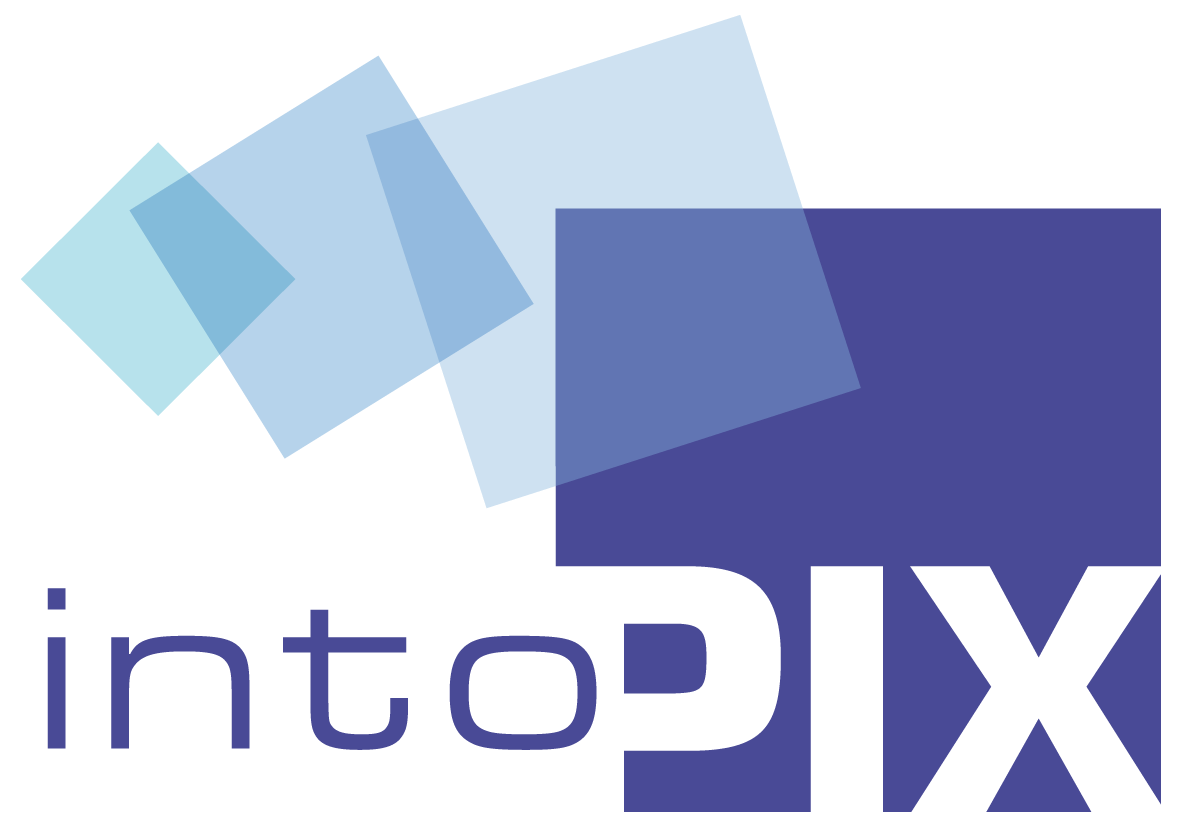JPEG 2000 by intoPIX
intoPIX's EMMY® Award-winning JPEG 2000 IP-cores protect high value images. Simultaneously handling deep color, high data rates and extensive JPEG2000 know-how, the IP-cores enable best-in-class picture quality.
Available for the most recent platforms and process nodes, intoPIX IP-cores allow its users to achieve unprecedented performances in terms of bit rates, frame rates, resolutions, power and scalability.
Benefiting from a modular architecture and completed with a wide range of peripherals and security IP-cores, intoPIX's solutions provide an easy, timely and cost-effective way to implement the JPEG 2000 technology with unique intoPIX added values
Ultra Low Latency mode
uniquely by intoPIX
Ultra-low latency mode (sub-I-frame) codes down to 2/16th of a frame (field) at the encoding and 1/16th of a frame (field) at the decoding with stripe border protection.
(e.g. down to 5 milliseconds with end-to-end compression in 1080p60 or 2160p60)

Key features
When image quality is a crucial asset ...
Discover our JPEG 2000 IP cores
intoPIX offers a large range of JPEG2000 Encoder / Decoder IP-cores optimized for various applications. Based on all the features that we are supporting, it is possible to provide custom versions to address your specific needs.
Contact us for your own configuration based on your selected FPGA platforms or ASIC and see hereunder a list of typical configurations:
Features
| Image/video features |
|
| JPEG 2000 compression (ISO 15444-1 and more) |
|
| Quality and Bit Rate Control |
|
| Latency |
|
| Control |
|
| FPGA/ASIC |
|
* If you are looking to avoid any DDR requirements , intoPIX provides other compression IP-cores without any external memory needs: TICO XS (JPEG XS), TICO RDD35 or TICO-RAW (sensor compression)
Encoder Architecture

Click image to enlarge
The first stage of the encoder is the Multiple Component Transformation, It may be used to improve compression efficiency, by decorreleting the luminance from the chrominance, e.g. converting RGB to YCbCr. 3 modes are accessible: Pass-through, reversible Lossless transform (RCT, prescribed for Lossless encoding)) and the irreversible transform (ICT).. Both, RCT and ICT, transformations are implemented with 18-bit fixed point precision.
Discrete Wavelet Transform (DWT)
A bi-dimensional wavelet decomposition of the sub-bands is performed with either the Le Gall (5/3) filter bank or the Daubechies (9/7) filter bank. The 5/3 filter is recommended for lossless encoding while the 9/7 filter offers a better compression efficiency for lossy encoding. Used with an 18-bit fixed point precision.
Quantizer
The coefficients of the wavelet sub-bands are quantized. The quantization steps are defined by the user and can be different for each sub-band.
Entropy encoder
Each wavelet sub-band is divided into several code-blocks and encoded using an Entropy Encoder. The encoder is divided into two blocks: the Context Modeler and the Arithmetic Encoder. The Context Modeler successively encodes each bitplane of the code-block by sending information describing the neighborhood of each bit to the Arithmetic Encoder. With this information the Arithmetic Encoder encodes each bit in order to generate the compressed bit-stream.
Rate Allocator
JPEG 2000 Generator
The JPEG 2000 Generator is responsible for generating the final codestream so as to provide a fully compliant JPEG 2000 image. This codestream generator is also responsible for the codestream structure accordingly to the scalability order selected by the user: by Resolution (R), by quality Layer (L), by Position (P) or by Component (C).
External memory
Interfaces
Input and output interfaces are based on FIFO protocols, and a burst of two pixels (in RBG, XYZ or YUV) is required at the input interface.
Process Controller
Taking full advantage of JPEG 2000 intra-frame coding, the intoPIX Encoder Process Controller accurately manages the frame stream. When there is no video to encode the processor will continue to provide the latest encoded frame, or stop outputting compressed data according to the user command. This process also configures the different JPEG 2000 options for the full encoding chain.
Decoder Architecture

Click image to enlarge
JPEG 2000 parser
The JPEG 2000 parser analyses the main and tile-part headers of the JPEG 2000 codestream and sends the compressed bit-stream to the entropy decoder.
Entropy decoder
The reconstruction of each wavelet sub-band divided into several code-blocks is achieved by two blocks: the Context Modeller and the Arithmetic Decoder. The Context Modeller successively decodes each bit-plane of the codeblock by sending information describing the neighbourhood of each bit to the Arithmetic Decoder. With this information, the Arithmetic Decoder decodes the bit-stream.
Inverse Quantizer
The coefficients of the wavelet subbands are inverse quantized. The quantization steps are defined in the main header of the JPEG 2000 file and can be different for each subband.
External memory
A frame memory buffer is used at the Inverse Quantizer output and enables an efficient IDWT processing. This buffer, containing a DDR-SDRAM external memory, always keeps at least one valid frame that can be repeated when convenient.
Inverse Discrete Wavelet Transform (IDWT)
A bidimensional wavelet recomposition of the subbands is achieved. Two filter banks, with a 18-bit fixed point precision, may be used: either the Le Gall (5/3) filter bank prescribed for lossless encoding or either the more complex Daubechies (9/7) filter bank for lossy encoding.
Multiple component transformation (MCT)
In the JPEG 2000 standard, in order to improve compression efficiency, multiple component transformations can be used. Depending on the wavelet filters used, different transformations are defined. The reversible transform (RCT) is used with the 5/3 filter, and the irreversible transform (ICT) with the 9/7 filter. Both transformations are implemented with a 18-bit fixed point precision.
Error Handling
The decoder is designed to detect errors in the input data and detection achieved at the main headers, and at the
coherence of tag trees. When an error is detected, specific error codes are sent to the device managing the decoder. In the case of a corrupted frame codestream, the decoder can try to decode the next frame. This can be repeated until a correct frame is encountered. If no frame can be decoded during the elapsed time determined by the frame rate, the previous correctly decoded frame is sent to the output to prevent display artifact.
Process Control
Taking advantage of the JPEG 2000 intra-frame coding, the decoder controller can manage the stream at the frame accuracy (or below with Ultra Low Latency mode). When there is no data to decode at its input, the decoder can loop on the latest decoded frame, output a black frame or stop to output frames. By controlling the input stream and the output options, the decoder controller can manage pause, step by step, slow-motion, fast forward and rewind, and random access.
Interfaces The input receives data by 32-bit bursts of in Little or Big-Endian representations. A burst of two pixels (RGB, XYZ or YUV) is output. The output clock depends on the sequence frame rate and picture size.

AMD-Xilinx FPGA & SoCs IPs
From Spartan to Artix, Kintex, Zynq, Virtex families
ASIC IPs
Tell us more about your needs

Intel-Altera FPGA & SoCs IPs
From Cyclone to Arria & Stratix families
What our users say

Sony Digital Cinema
Toshihiko Kitazawa, Senior Technical Manager DC Department

Audinate - DanteAV
“One of the benefits of this new product is the ability to transport everything over a 1Gigabit network. And this is a result of the compression we’re using. The codec from intoPIX allows us to do that not only seamlessly but with high quality and a 4K definition.”
Lee Ellison, CEO

Artel Video Systems
“In developing our solution, we chose the intoPIX core as it has rapidly become the industry standard."
Richard Dellacanonica, President

Crestron
“intoPIX’s JPEG 2000 ultra-low-latency technology is integral to the ability of the DigitalMedia NVX Series to transmit 4K60 4:4:4 HDR video with the full capabilities of a standard 1 Gigabit Ethernet network, and with no latency. It represents a dramatic leap forward in the transport of high-performance video over IP networks."
Steve Samson, Executive Director Business Development

Media Links

NEC Display Solutions
“We have selected intoPIX because of their know-how in the JPEG 2000 compression technology field, their smart single chip FPGA implementation and their integration support.”
Atsushi Kuroda, General Manager

Nevion
“We selected intoPIX JPEG 2000 technology for the VS902 platform based on its performance, interoperability and full compliance with the latest technology standards such as the JPEG2000 Broadcast Profile. In addition, their dedicated support and expertise in JPEG 2000 technology enables us to develop highly customized solutions for our customers.”
Dr. Chin Chye Koh, Product Manager

NTT AT
“intoPIX JPEG 2000 high quality codecs are the perfect answer to the challenge of providing more pixels and higher frame rates to the audio-visual industry. With JPEG2000, the video quality always remains exceptional for all formats. It is a frame by frame compression, scalable in resolution, and it compresses pictures in a visually or even mathematically lossless way with a very low latency.”
Hitoshi Takanashi, Business Unit Manager
Related IPs & SDKs
- JPEG 2000 HD Encoder / Decoder IP-cores for FPGA & ASIC
- JPEG 2000 Digital Cinema Encoder/Decoder IP-cores for FPGA & ASIC
- JPEG 2000 UHDTV 4K/8K Encoder/Decoder IP-cores for FPGA & ASIC
- JPEG 2000 Mathematically Lossless (up to 16bit) Encoder / Decoder IP-cores for FPGA & ASIC
- Multiport DDR Memory controllers IP-cores for FPGA optimal for JPEG2000 Encoder/Decoder IPs and other IPs
- MPEG2-TS Encap/Decapsulation IP-cores for JPEG2000 VSF TR01 (version 1 & version 2)
- Encryption / Crypto (AES, RSA, HMAC-SHA1, Watermarking interface ) FPGA IP-cores



















